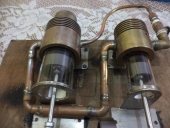

























QuickBooks set up and Bookkeeping for Small Businesses and Farms - jocelyncampbell.com












































joe capcom wrote:hi, I have just built this stirling engine. but there seems to be some problem. it doesn't startup. basically, it isn't running. I use a butane torch as the heat source but still there isn't enough power to run it. can I get some advice on how I can get it running. initially there was too much torque, so I reduced the stroke length but it still will not run. I am unable to identify the problem.nsome advice would be helpful, thanks
the pic of my model is in the attachment.








joe capcom wrote:hi marcos,
thanks for the ideas. that's some info I can use there. I am already working on some of the things which has been affecting the heat transfer and efficieny.
reccomendations:
1) I have a flywheel for this engine, not visible in the picture.
2) yup, that is my idea now and I am working on it also. I was thinknign of using an aquarium pump too. do yo know of any stirling engines which water cools using an aquarium pump??
3) ok, that would be a good idea to vary the load according the output.
4) pressurize the air in the engine, meaning I should have the internal of the engine at a higher pressure before I heat it up? how does this help with the engine efficiency or its ability to run?
thanks








Balint Bartuszek wrote:
If you want to dream a bit though, do a search on youtube: "sunvention"
Sun powered stirling engines, cool eh?
I-Roof Technologies
Solar Hot Air Generator
I-Roof
Concept
With locally available low cost, corrugated roofing elements, Sunvention's special, highly transparent and extremely durable Miraflow film selective black painting, backside therma l insulation and optimized Air Channel Geometry, an effective and economic I-Roof Solar Hot Air Generator is created.
It requires no electrical energy to pump the air to be heated - the automatically created convection fulfill this task. The outlet air temperature of the I-Roof can be controlled over Air Duct Cross Section.
Applications
The I-Roof elements can be used in different configurations:
As convective Solar Dryer “I-Dryer”, typically for sea weed, bananas and all sort of fruits. It is modularly extendible, according to the local need. Beside regulating the drying temperature via the cross section of the Air Duct it is also possible to combine the “I-Dryer” with special PCM storages extending the operational hours over the day time.
As convective Solar Roof, “I-Roof”, to climatize houses and produce simultaneously domestic hot water
As Sea-Water desalination plant “I-Desal”.




joe capcom wrote:I see, I get it. I am actually working on some of the improvements such as reducing dead space, sealing all air leaks and making the engine look a little more presentable...
currently the most trouble I am facing is sealing the air leaks. sometime I can hear the hiss sound but just couldn't identify the leak so, I covered up all the possible leak spots with some rtv sealant.. just waiting for the sealant to dry before I fire it up for a test run.. will try to pressurize the air before I run it.
yea, thanks for the compliments.. the designing work was mine but the brass part were machined using a lathe in a machine shop. someone did it for me...












joe capcom wrote:that's some info we have here... yea, it does interest me. im eager to get building newer ones but, I want to make the current one run first. all others comes next.. hahah
thanks man




Marcos Buenijo wrote:
joe capcom wrote:that's some info we have here... yea, it does interest me. im eager to get building newer ones but, I want to make the current one run first. all others comes next.. hahah
thanks man
I looked at the engine again, and while I'm no expert on small stirling engines, I have to say this engine doesn't look right.
You want there to be very little volume in either cylinder when its piston is fully retracted. I can't see how it's designed, but it seems like the glass is used as the sealing cylinder, and the pistons retract into the volume contained by the metal cylinders. I like that part, but I can't see how far the pistons retract. They should go all the way to the cylinder heads and close the volume as much as possible. I don't see the purpose of the large connecting tube that snakes around the engine unless it contains a regenerator. That fat tube is way too much dead air space that only robs efficiency since that air cannot be heated. Also, what's the purpose the the thinner tube?... why are the cylinders connected with two different tubes? It seems you should connect the two cylinders directly across with a single short tube about the diameter of the larger tube. The larger piston should be advanced 90 degrees ahead of the smaller piston with the large cylinder heated and the other water cooled. This is what I'm seeing, but I can't get inside your head, so work with me.

|
If you're gonna buy things, buy this thing and I get a fat kickback:
The new gardening playing cards kickstarter is now live!
https://www.kickstarter.com/projects/paulwheaton/garden-cards
|






